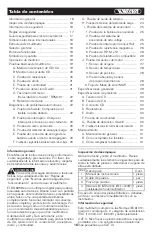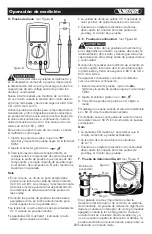
Multimeter Basic Testing
7
1. Set the rotary switch to RPMx10.
2. As prompted at the LCD connect terminal,
insert the red test lead into the terminal
and the black one into the COM terminal. Select
an appropriate number of cylinders. Connect the
ends to be tested as illustrated.
• If
a DIS ignition system without any distributor
board is used in the automobile, connect the red
test lead probe to the TACH (tachometer) signal
line (which is connected to the computer DIS
module of the automotive engine). Refer to the
automotive servicing manual for the specific
position.
• If
an ignition system with a distributor board is
used in the automobile, connect the red test lead
probe to the primary negative end of the ignition
coil. (Refer to the automotive servicing manual for
the specific position.)
3. Connect the black test lead probe to the good
ground terminal of the automobile.
4. Upon the start of the engine or during its
operation, test the rotation speed of the engine
and read the displayed value from the display.
The actual rotation speed of the automobile to
be tested should be equal to the displayed
value multiplied by 10. For example, the actual
rotation speed of the engine of the automobile
should be 2000 RPM (200 x 10) if the displayed
value is 200 and the multimeter is set at the
6CYL (6 cylinders) notch.
Under any testing circumstances, the display of
the meter holds the testing result as soon as the
HOLD is pressed down. When the HOLD is
pressed once more, the testing result held in the
display of the meter will be unlocked immediately
and the meter randomly shows the current testing
result.
Diagnosis of Automotive Troubles
The digital multimeter is a tool for the very effective
diagnosis of the troubles with the electronic
systems of the automobile. This part gives a
special introduction as to how the multimeter is
used to diagnose any trouble with a fuse, switch,
solenoid, relay, starting and charging systems,
ignition system, fuel system and engine sensor.
A. Fuse Testing: Check the fuse to see if it
is blown out.
1. Set the rotary switch to 200
Ω
.
2. As prompted at the LCD connect terminal,
insert the red test lead into the
Ω
terminal and
the black one into the COM terminal.
3. Short circuit the red and black test lead probes,
when the reading of the meter should be
displayed between 0.2
Ω
and 0.5
Ω
If it is more
than 0.5
Ω
, check the test leads to see whether
they are well connected.
4. Connect the red and black test lead probes in
parallel to the two ends of the fuse, when the
reading of the multimeter should be displayed
H. Data Holding
less than 10
Ω
, indicating that the fuse is good.
When the display is overload “1”, it is shown
that the fuse has been blown out.
• It must
be replaced with a fuse of the same type
and size.
B. Switch Testing: Check the switch to see if
it can work correctly.
1. The same as in Items 1 to 3 (Fuse Testing).
2. Connect the black test lead probe to one end
of the switch and the red one to another end.
When the switch is connected, the reading of
the meter should be displayed less than 10
Ω
.
When the switch is cut off, overload “1” should
be displayed as the reading of the meter.
C. Solenoid or Relay Testing
1. The same as in Items 1 to 3 (Fuse Testing).
2. Connect the red and black test lead probes in
parallel to the two end of a solenoid or relay.
The impedance of most of solenoids or relay
coils is less than 200
Ω
.
(See the details in the automotive manual.)
• Check to see if there is any damaged coil. Even
if the coil is found satisfactory, the solenoid or
relay may still be damaged. The relay may be
welded or worn due to the frequent sparking of
the contacts. The solenoid may be stuck when
the coil is in an on-position. Therefore some
potential problems cannot be found in testing.
D. Starting/Charging System Testing
The on-off package of the engine starting system
consists of a battery, engine starting button,
solenoid and relay starting buttons, lead
connections and lines. During the operation of the
engine, the charging system keeps the battery
charged. This system consists of an AC generator,
voltage calibrator, lead connections and circuits.
The multimeter is an effective tool for the checking
of these systems.
1. Load-Free Battery Testing Before testing the
starting/charging system, test the battery to see
if it is fully charged.
(1) Set the rotary switch to 20 VDC.
(2) As prompted at the LCD connect terminal,
insert the red test lead into the V terminal and
the black one into the COM terminal.
(3) Turn off the ignition switch.
(4) Turn on the driving lights for 10 sec. to
release charges from the battery.
(5) Connect the black test lead probe to the
negative pole of the battery and the red one
to the positive pole of the battery.
Measurement Operation(13)
2. The testing results are shown in contrast as
follows and if the battery is less than 100%,
please use it after charging it.
• Both ends of a general solenoid or relay
are connected with diodes.
WARNING
Содержание KN 8056
Страница 1: ...KN 8056 Digital automotive multimeter Mult metro digital automotriz...
Страница 33: ...Notes Notas...
Страница 34: ...www knova com mx...









































